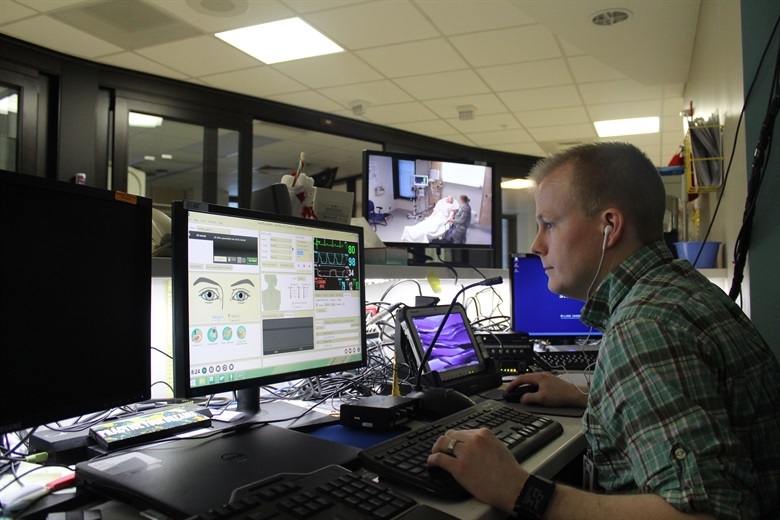Comprehensive Healthcare Simulation: Operations, Technology, and Innovative Practice is a crucial book for Clinical Simulation programs looking to maximize the efficiency of their operations. From the basic theories to advanced practices, the latest healthcare simulation book has been praised by readers as a “Must Read” item for anyone operating, managing, or starting a medical simulation center. Previously we shared Chapter excerpts on the “Types of Healthcare Simulation” and “Medical Simulation Methodologies“, and today we take a closer look at Pamela Andreatta’s EdD, PhD, MFA, MA, FSSH, NPCT chapter on Simulation Center Personnel. The powerful chapter the three key domains of simulation staff, and what specific roles and responsibilities simulation center directors will need to fully understand to be successful at building and maintaining a simulation in healthcare program.
There are many types of simulation centers and the staffing required to optimally support the mission of any center will largely depend on its size, diversity of users, educational aims, institutional goals, and funding model [1–8]. Simulation centers may be privately or publicly funded; non-profit or for profit; unaffiliated (independent) or affiliated with a hospital, medical center, university, institutional department, commercial enterprise, governmental or non-governmental agency. Simulation centers may range from small, discipline-specific initiatives within a department to large national and international enterprises that support all aspects of ability development, research, and credentialing in clinical, surgical, team, logistical, and operations performance domains. Although less comprehensive than large- scale multidisciplinary centers with broad scope, small centers – such as those with surgical trainers situated in a call room or airway and line placement trainers organized in a patient bay for use by clinicians on an ad hoc basis — still require personnel to support their successful uptake and impact. This chapter addresses the personnel requirements for simulation centers of all forms, with indications for which roles are essential and which roles are flexible for small- and medium-sized centers.
There are three personnel roles that all centers will need, regardless of their size: designated executive administration (e.g., executive director, director, man- ager, etc.); technical operations support (e.g., coordinator, technologist, technician, etc.); and educational assistance (e.g., instructors, trainers, facilitators, etc.). The responsibilities for these roles (and others) are delineated further in this chapter; however they collectively serve to cover the managerial and administrative considerations, technology and operational management tasks, and instructional and training efforts for the simulation programs a center supports. Larger centers will likely require these primary roles to be subdivided into more discrete functions, especially if the center supports multidisciplinary programs and further still if it supports interdisciplinary programs across specialties and institutions.
The primary aim of staffing a simulation center is to provide the expertise and personnel necessary to meet the mission and objectives of the center’s stakeholders. It is imperative for these to be delineated and carefully considered early in the planning stages, before hiring personnel, designing space, and purchasing equipment. This will assure the best possible approach to staffing to meet a center’s overall goals within its operational and budgetary resources. It is important to note that simulation center personnel may function in multiple capacities and share the responsibilities of many roles.
Here then are brief excerpts of the great detail Dr. Andreatta covers in the Chapter:
Executive Director: The executive director role may alternately be referred to as director, administrative director, or similar. He or she is ultimately responsible and accountable for the decisions associated with center operations and how they meet its established mission and objectives. The executive director will coordinate and communicate with the center’s stakeholders, as well as with external agencies and professional organizations to assure the center aligns with, and contributes to, best practices in simulation- supported training, instruction, assessment, and research. The executive director will help establish and oversee policies and procedures for the center. He or she will also assure that any requirements for accreditations, certifications, credentialing, and regulations are met, documented, and distributed as necessary.
Steering Committee: Simulation centers support a wide variety of missions and objectives; however they all have constituent stakeholders who are committed in one form or another to their success. Although not considered center staff, a steering committee comprised of decision-makers, influential stakeholders, and relevant institutional executives is critical to the ongoing success of any simulation center. These personnel provide guidance on overall strategic direction, program development, resource allocation, budgeting and staffing recommendations, and procurement decisions.
Educator: Educators – who may also be referred to as faculty, trainers, instructors, or facilitators – are an essential component to successful simulation centers. Educators may be in full-time staff positions, but more often they are part-time and even ad hoc personnel with applied expertise in a given clinical, surgical, or health professions domain. Educators primarily facilitate instruction during simulated events, which might also include operational management of simulators and facilitation of debrief– ing activities following a simulated event.
Debriefing Facilitator: Debriefing facilitators support the critical role of debriefing after a simulated train- ing event that typically includes interdisciplinary team management of manikin– facilitated patient care. These may be emergent, urgent, or general patient care activities wherein clinicians from multidisciplinary specialties coordinate their actions to diagnose, treat, and stabilize patients, who are represented by manikin simulators or standardized patients. Debriefing staff may include the educators tasked with supporting a simulation event, or they may be staff designated to facilitate the debriefing event itself.
Operations Director: The role of operations director is one of the most critical in any simulation center. Larger simulation centers, and those with a multidisciplinary scope, will almost certainly require an operations director to organize activities, serve as liaison between the center’s executive leadership and operations staff, implement administrative and operational decisions, and direct facilities management functions. An operations director will coordinate schedules for center functions, equipment usage, personnel support, procurement and purchasing, and logistical considerations associated with instruction, assessment, research, tours, meetings, and other events deemed necessary by the center’s stakeholders.
Simulation Technologist: Simulation technologists are specialists who program, set up, and operate simulation equipment for use during simulated events. These personnel are critical for centers with a wide variety of high-technology simulation equipment, such as human patient manikins, computer-based surgical trainers with haptic feedback interfaces and advanced 3-D graphics, virtual and augmented reality systems, computer-supported task trainers, mobile and field-situated simulation events, and immersive environments such as a cave automatic virtual reality environment (CAVE). The simulation technologist will program manikins and software controls for other educators, troubleshoot simulators that are not operating as expected, per- form simulator maintenance, install software updates, and coordinate with information technologists to assure connectivity of simulators and clinical equipment with a center’s IT infrastructure.
Simulation Technician: Implementation of activities and events within a simulation center requires ongoing coordination, setup, implementation, takedown, and maintenance of facilities, equipment, and supplies. Simulation technicians facilitate activities and events by managing inventory and availability of beds, gurneys, chairs, tables, lighting, scrub sinks, curtains/dividers, linens and gowns, clinical equipment Simulation Center Personnel 55 (e.g., 12-lead ECG, laryngoscope), clinical and surgical instruments (e.g., scalpels, forceps), medical supplies (e.g., catheters kits, gloves, gauze), and simulated treatments (e.g., medications, fluids, oxygen). They will set up and verify the configuration and operation of equipment and resources to be used during planned activities, and likely collaborate with educators and other staff to test the feasibility of protocols or scripts when events are developed.
Other Positions Covered in this Chapter:
- Developers/Modelers
- Control Room Technician
- Information Technologist
- Coordinator/Manager
- Content Experts
- Standardized Patient Coordinator
- Debriefing Facilitator
- Assessors
- Education Director
- Developers/Modelers
- Administrative Assistants
- Director(s): Medical, Surgical, Nursing, and Health Professions
- Research
- Director
- Assistants
Wow — there are so many positions to consider for your simulation labs!
About Dr. Pamela Andreatta
As a globally renowned expert studying human performance in Medicine, Surgery, Nursing, and Health Professions, Dr. Andreatta consults with numerous industry, government, philanthropic, academic, accrediting and regulatory partners who are committed to improving human performance in medicine, surgery, nursing, and health professions. She is an internationally recognized leader and expert human performance investigator responsible for over $25M research on six continents.
More Key Take Aways From Latest Simulation Operations Book Include:
- Practical guide helps prepare professionals for the broad scope of simulation in healthcare
- Defines the domains of medical simulation operations
- Focuses on the development of the healthcare simulation technology specialist
- Written and edited by leaders in the field of clinical simulation
Written and edited by leaders in the field, Comprehensive Healthcare Simulation: Operations, Technology, and Innovative Practice is optimized for a variety of learners, including healthcare educators, simulation directors, as well as those looking to pursue a career in simulation operations as healthcare simulation technology specialists. Grab your copy today!








